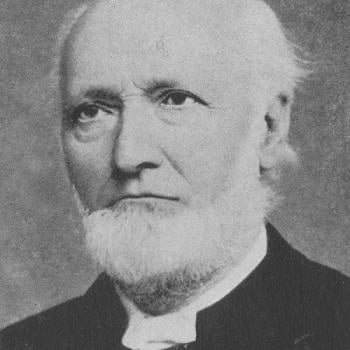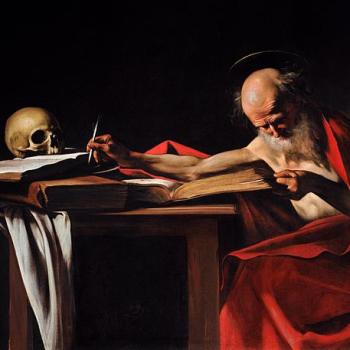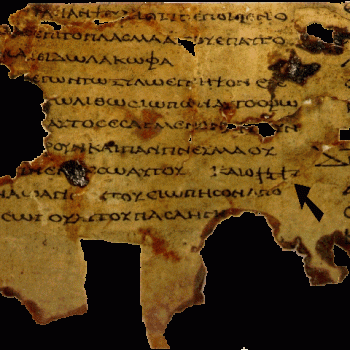Chapter 5 of my book (available for free online), Inspired!: 198 Supposed Biblical Contradictions Resolved. See the Introduction and ch. 1: How Do Atheists Define a “Biblical Contradiction”? All Bible passages RSV unless otherwise noted.
- Did Jesus (Matt. 3:16; Mark 1:10) or John the Baptist (John 1:32) see the Holy Spirit descending like a dove at his baptism?
They both saw the same thing. So what? If my wife and I both see a meteor lighting up the night sky, that’s somehow a “contradiction”?! Remember, that’s what all of these are supposed to be, according to our never-ending critics. A real contradiction would be, for example, Matthew and Mark saying that only Jesus saw this, and John stating that only John the Baptist did.
- Did Satan tempt Jesus (Matt. 4:1-10; Mark 1:13; Luke 4:1-2) or have no interest in him at all (John 14:30)?
This is ridiculous. Jesus merely notes in John that the devil had “no power over” him. This has nothing to do with whether Satan would try to tempt him or not. He would and did because he is stupid, and doesn’t know that he’s completely out of his league, in trying to manipulate Jesus. Any being who is present with God in heaven and chooses to rebel and leave “for better things” has to be absolutely the dumbest and most clueless and tragic creature imaginable.
- Did the devil take Jesus to the pinnacle, then to the mountain top (Matt. 4:5-8) or the other way around (Luke 4:5-9)?
Matthew doesn’t specify sequence. He writes: “Again [as opposed to “later” or “afterwards”], the devil took him to a very high mountain . . .” (4:8). Nor does Luke indicate sequence. He says, “And he took him to Jerusalem, and set him on the pinnacle of the temple . . . ” (4:9). Therefore, a contradiction of sequence cannot occur, since sequence isn’t specified in the first place. Accounts mentioning multiple events in a single setting don’t always indicate the order in which they occurred (nor are they obliged to). For example, if I say, “I went to Burger King and I also went to the grocery store,” this is not necessarily a declaration of exact sequence. But if I specified an exact time for each visit and mixed them up in two different recollections, that would be an actual logical contradiction.
- Did Jesus teach that good works should be seen (Matt. 5:16) or not seen (Matt. 6:1-4)?
Matthew 5:16 lays out the principle that good works are good in and of themselves and are a witness to Christianity; therefore, it’s good that they are seen, so that people can “give glory to your Father who is in heaven.” Matthew 6:1-4, on the other hand, refers to a more specific, internal thing: the mentality of pridefulness and doing works not simply because it is the right thing to do, but “in order to be seen” (6:1); in other words, an outlook of “look how wonderful I am, since I am doing all this good stuff. Come and praise me!” In the first scenario, the intention is to glorify God; in the second, it is one’s own inflated ego and pride. In Matthew 6:2 Jesus gives the example of people sounding trumpets when they give alms “that they may be praised by men.” That’s what he’s talking about in that instance: pride when doing good works; being sure to be noticed and seen, out of a prideful motivation; not that good works should never be seen at all. It’s two different topics, and so according to the laws of logic, it’s no contradiction.
- How can Jesus command us to love our enemies (Matt. 5:44), yet approve of destroying enemies (Luke 19:27)?
Luke 19:27 is a parable about the final judgment (which is God’s sole prerogative). As such it has nothing directly to do with how we should approach enemies in this life, with a loving and forgiving spirit. We’re not anyone else’s Creator or Ultimate Judge.
- Was the Lord’s Prayer taught to many during the Sermon on the Mount (Matt. 6:9), or only to the disciples at another time (Luke 11:1)?
It looks like Jesus simply repeated the prayer (no law against that!): seeing what importance it would have in the history of the Church, as the collective Christian prayer: the most well-known of all. Repetition is a great teacher. In Luke, he taught it to his disciples in a shorter version. Luke 11:1-4 never states that he did so only with them at this time. That is wrongly read into the passage by the skeptic who came up with this. Then Jesus expanded the Our Father prayer and taught it to the “crowds” (Matt. 5:1; 7:28) in the Sermon on the Mount. None of this is implausible or unlikely to the slightest degree, and it certainly isn’t a “contradiction.”
- Are we to not worry at all about tomorrow, because God will take care of us (Matt. 6:25-34; Luke 12:22-31), or is a man who does not provide for his family worse than an infidel (1 Tim. 5:8)?
Matthew 6:25-34 (Luke is a parallel passage) is about anxiety, and how God provides our basic needs, and it’s very good, practical advice: especially “Let the day’s own trouble be sufficient for the day” (Matt. 6:34). In other words: “we’ll cross that bridge when we come to it” or “one day at a time.” We can’t worry about all the “what ifs”. That will drive us crazy. It’s not a denial that we should be responsible in providing a living for ourselves and our families. “Don’t worry” is not the same thought as “don’t provide” or “don’t work and be a lazy bum.” Therefore, it’s one of innumerable cases of “apples and oranges”: as so many of these are. They have nothing to do with each other. It has to be the same subject matter to possibly be a contradiction. The first two passages simply don’t disagree with the third, and Paul is quite firm about the wrongness of sloth and able-bodied people not working (2 Thess. 3:6-12).
- Why did Jesus say that salvation was only for the Jews (Matt. 10:5-6; 15:24; John 4:22; Rom. 11:26-27), while Paul wrote that it was also for the Gentiles (Acts 13:47-48)?
Jesus and the disciples first concentrated on the Jews, because they were God’s chosen people, who had carried the message of his salvation for the previous 1700 or so years: since at least Abraham (and they were all Jews as well). Then the plan was for the gospel to be preached to all and sundry (Matt. 24:14; 28:19; Acts 10:34-35; Rom. 2:9-16; 2 Pet. 3:9). But instructions to preach to the Jews only in one place and time (Matt. 10:5-6) are not logically antithetical to a later outreach to the Gentiles. And Jesus saying that he was “sent only to the lost sheep of the house of Israel” (Matt. 15:24) doesn’t preclude or exclude his disciples later doing otherwise. Jesus in John 4:22 says, “salvation is from the Jews”: which has nothing to do with the topic at hand. Historically, it was indeed from the Jews, as God’s chosen people. But that’s a non sequitur in relation to this attempted claim of contradiction. Moreover, Romans 11:26 states that “all Israel will be saved.” The problem for our skeptic is that this is not to the exclusion of the Gentiles, since the previous verse stated, “until the full number of the Gentiles come in” (i.e., are saved). This entire miserably failed attempt is shot-through with shoddy, sloppy, illogical thinking, as shown.
- Why was Jesus thankful that some things are hidden (Matt. 11:25; Mark 4:11-12) in light of his saying that all things should be made known (Mark 4:22)?
In Matthew 11:25 Jesus states: “I thank thee, Father, Lord of heaven and earth, that thou hast hidden these things from the wise and understanding and revealed them to babes.” Mark 4:11-12 is about Jesus’ use of parables. He deliberately used them, knowing that those who don’t want to know the truth won’t grasp them. Then he sarcastically decried the notion of their freely chosen obstinacy: “that they may indeed see but not perceive, and may indeed hear but not understand; lest they should turn again, and be forgiven” (Mark 4:12). In Mark 4:22, on the other hand, Jesus teaches that the state of affairs just described will not be permanent; that one day “there is nothing hid, except to be made manifest; nor is anything secret, except to come to light.” Thus, a temporary, limited “hiddenness” simply isn’t contrary to the idea that things won’t always be this way.
- Did Jesus heal two blind men (Matt. 20:29-30) or only one (Mark 10:46-52)?
I tend to believe in an instance like this that there were two similar traditions in existence about one event (just as eyewitnesses in a court trial will differ on some details): one of them had one blind man and the other had two. But as far as contradictoriness goes, what we know about this incident doesn’t establish it, according to the laws of logic. Mark 10:46 and also parallel verse Luke 18:35 do indeed state that one blind man was healed. But neither claim that “only one” was (which would be required for a contradiction). “One” doesn’t logically exclude a possible second man. “Only one” does. Elementary logical errors of this sort are annoyingly common in “atheist laundry lists” of alleged contradictions. If atheists want to keep making these silly and embarrassing mistakes, apologists like myself will be all too happy to correct them. But it would be better for all if they would attempt to be rigorously logical and not so sloppy in their analyses. I’m actually offering constructive advice for their future critiques throughout this book.
- Did Jesus go to Bethphage and the Mount of Olives, then to Bethany (Matt. 21:1, 17), or to Bethphage and Bethany at the Mount of Olives (Mark 11:1; Luke 19:29), or to Bethany and then Jerusalem (John 12:1, 12)?
Bethany and Bethphage are both located on the eastern slope of the Mount of Olives. They are only 2.8 miles from each other. In Matthew, it’s reported that Jesus came through Bethphage, then down the western slope of the Mount of Olives to Jerusalem. That night (Palm Sunday), he went back up the mountain to lodge in Bethany. Mark adds that he also went through Bethany on his way to Jerusalem (which is not a contradiction), and agrees that he stayed in Bethany overnight (11:11-12). So far so good. Luke agrees with how Mark describes the journey: Jesus went through both Bethany and Bethphage on the Mount of Olives, but doesn’t include the detail of his staying in Bethany that night. None of this is contradictory in the slightest. Not every Gospel includes every detail of a story (or is logically required to). John’s account mentions that Jesus went through Bethany en route to Jerusalem on Palm Sunday, without also mentioning Bethphage, or the night spent in Bethany after he was in Jerusalem. But of course, this is not contradictory, either. All of the accounts complement each other. A true contradiction would be something like, “Jesus went only through Bethphage on the way to Jerusalem on Palm Sunday” according to one account, and another Gospel saying “Jesus went only through Bethany on the way to Jerusalem on Palm Sunday”. That‘s a contradiction, but nothing like that is in the four Gospel stories of the same broad events. So, no dice. Sorry, skeptics! You try so hard . . . A for effort, E for your conclusion.
- Why did Jesus curse the fig tree so that it wouldn’t bear fruit (Matt. 21:19; Mark 11:14), when it wasn’t time to bear fruit (Mark 11:13)?
To note that it wasn’t the season for figs (Mark 11:13) is different from Jesus saying, “May no fruit ever come from you again!” (Matt. 21:19) and “May no one ever eat fruit from you again” (Mark 11:14); therefore, this is no contradiction. This objection is what is known in logic as a non sequitur (Literally, “it doesn’t follow”).
- Did the fig tree wither immediately, amazing the disciples (Matt. 21:19-20), or did they first notice that it was withered the next day Mark 11:20-21)?
The objection itself doesn’t accurately describe what these passages assert. Mark doesn’t indicate when the fig tree withered, but informs us that the disciples saw it withered on the next day. Matthew, on the other hand, notes that it withered immediately, but doesn’t specify exactly when the disciples saw it. It provides no reference to time span. Therefore, we have no indisputable logical contradiction in this instance. It would be an example of “apples and oranges” (or should I say, “apples and figs”?).
- Was the kingdom of God prepared from the beginning (Matt. 25:34), or was it prepared by Jesus after he died (John 14:2-3)?
It was “from the beginning” in the sense that God knew all about it and ordained it: being out of time and knowing all things. To “prepare something” when it is about to be implemented is not the same thing as having known about the thing for a long time beforehand. So, for example, one of my two granddaughters is having her first birthday party tomorrow. Her parents are busy preparing for it. They have known that there would be such a party (for whatever children they had) from the time even before she was born (and we knew it, too). It’s not “contradictory” to prepare for it when the time arrives. Another example would be King Charles III of England. He has known from birth that he would likely be king, and hence was “prepared” for that from the early 1950s. But now as I write he’s actually preparing for it more specifically and tangibly in his upcoming coronation.
- Will the righteous have eternal life (Matt. 25:46) or are they barely saved (1 Pet. 4:18)?
I see no conflict here at all (apples and oranges). The proposed “contradiction” isn’t even coherent. It makes no sense, and reeks of desperation. The ones who persevere in good works (as a general proposition) will have eternal life, according to the context of Matthew 25. At the same time, salvation is difficult to attain (another general proposition).
- Did Peter deny Jesus before the cock crowed once (Matt. 26:34, 74; Luke 22:34; John 13:38) or twice (Mark 14:30, 72)?
Note that Mark’s second crow is after a first one, with a gap of time. This is key to understanding the non-contradiction. RSV doesn’t indicate when the first crow occurred, but KJV, utilizing a different (later, inferior) manuscript, has it after the first denial (14:68). Then after his third denial, the Gospel of Mark reads “And immediately the cock crowed a second time” (14:72). This alleviates any supposed difficulty, because it’s not a matter of “one crow only” vs. “two crows in a row at one time” (after the third denial). Rather, we must note what each Gospel was specifically referring to. Matthew, Luke, and John all refer to what Mark states is the second crow: that occurred after Peter’s third denial. But none of the three states that this particular crow is the “only” one. Therefore, it’s not contradictory. Nor does it become one simply because three Gospels didn’t mention an additional earlier crow made after the first denial (argument from silence).
- How do we harmonize texts asserting that Peter’s second denial was to another maid (Matt. 26:71-72), the same maid (Mark 14:69-70), to a man (Luke 22:58), and to more than one person (John 18:25), and that his third denial was to several bystanders (Matt. 26:73-74; Mark 14:69-70), to one person (Luke 22:59-60) and to a servant (John 18:26-27)?
Matthew specifies “another maid” (26:71), and “bystanders” (26:73). In the latter instance, a direct quote is given, so it is likely from just one of them, as they would not — obviously — all say in unison exactly the same words. In Mark it is “the maid . . . began again to say” (14:69), and “the bystanders” (14:70), again with a direct quote for the latter, suggesting that only one person said it. The only possible difference with Matthew is whether it was the same maid or a second one in the second instance. “Again” may have the meaning of “in addition to the first maid.” Luke says it was “some one else” (22:58), and “still another” (22:59). That’s perfectly consistent with both Mark and Luke, provided my explanation for the “second maid” in Mark is accepted. John has “They” (with an exact quotation: 18:25), which can be an unspecified second maid (per Matthew and Mark), and “One of the servants of the high priest, a kinsman of the man whose ear Peter had cut off” (18:26). This is a specified person, which is consistent with a “bystander” (Matthew and Mark) and “still another” (Luke). No undeniable inconsistency exists across the four accounts. Some descriptions are merely more vague. If I’m called by four different people, “a man”, “a Catholic apologist”, “Dave”, and “a guy raised in Detroit” this is not contradictory at all, as all four descriptions are true statements. The one point that might be suspected to be a contradiction (Mk 14:69) has a perfectly plausible explanation.
- Did Jesus refuse to answer any of the charges against him (Matt. 27:12-14; Luke 23:9), some of them (Mark 14:61-62), or all of them (John 18:33-37)?
In Matthew 27:11, right before the passage above, Jesus answered Pilate’s question: “Are you the King of the Jews?” by saying, “You have said so”: which was another way of saying “yes”. Matthew 27 dealt with Jesus’ second appearance before the high priest, scribes, and elders: on the morning of the day of his crucifixion. The previous meeting / monkey trial was the night before, and he definitely answered the question of the high priest (Matt. 26:63-64). But in the second meeting, he didn’t answer them (27:12). Why bother? They had already concluded He was a blasphemer, worthy of death, the night before. There was nothing left to talk about, from Jesus’ perspective. Jesus had already said what he needed to say, to bear witness to himself. In Luke 23:9, we learn that Jesus didn’t answer Herod. Mark 14:61-62 records Jesus giving essentially the same answer to the high priest that Matthew records in 26:64. Thus far, no contradiction at all. John 18 is about Jesus’ replies to Pontius Pilate. He responded with a rhetorical question regarding being King of the Jews, and then two “straight answers” about the same thing, which are perfectly harmonious with Matthew 27:11. Where, then, is the contradiction?
- Did the chief priests and elders persuade the people to ask for the release of Barabbas (Matt. 27:20), or only the chief priests (Mark 15:11), or did the chief priests and the people persuade themselves (Luke 23:13-23)?
Mark doesn’t claim that “only the chief priests” persuaded the people. Thus the above characterization is a misrepresentation of the biblical text. Mark wrote that “the chief priests stirred up the crowd”. Yes they did; so did the elders. The lack of an exclusive term like “only” in Mark accounts for the difference between a contradiction and two complementary statements. This is an example of the latter. Reading the three stories side-by-side, we see that the priests and elders seek to persuade the people to release Barabbas. Mark mentions only one (so what?: it’s an argument from silence). After that, (in Luke) Pilate calls them and the common people together to find out who they want released. It’s all perfectly harmonious. Logic 0101.
- Were James and John with Jesus when he healed Peter’s mother-in-law (Mark 1:29-31) or not (Luke 4:38-39; 5:10-11)?
Mark mentions that James and John were present, and so they were. Luke doesn’t mention that tidbit, but also doesn’t deny it. He doesn’t write something like, “Jesus alone entered . . .”: which would be an actual, authentic contradiction. Hence, this is another always-lousy argument from silence, and in no way, shape, or form proven to be a logical contradiction.
- The scribes who put together the Gospel of Mark included two versions of the same story of Jesus miraculously feeding crowds of people (Mark 6:32-44 and 8:1-10). This is more proof that Mark wasn’t an eyewitness.
This is untrue, and easily shown to be so. The two events took place in two entirely different locations, as the text states. The feeding of the 5,000 was near Bethsaida, which was on the north side of the Sea of Galilee (Mark 6:45; cf. Luke 9:10-17). The feeding of the 4,000, however, was a completely different story that occurred in a different place, in “the region of the Decapolis” (Mark 7:31), which was east of the Sea of Galilee, and included the town of Hippos. There is evidence that the place where the feeding of the 4,000 occurred was near the archaeological site of Kursi. Immediately after the miracle, according to Matthew 15:39, the parallel verse, Jesus “got into the boat and went to the region of Magadan” (another name for Magdala, where Mary Magdalene was from). That would have been directly across the Sea of Galilee. In any event, it’s clearly two entirely different places being described in the stories of the two feedings. They are perfectly harmonious and non-contradictory (just as my eating breakfast at home and lunch at a restaurant is not a “contradiction”).
- How did Mark know what Jesus said in his private prayer in Mark 14:32-36? Jesus specifically goes out of his way to leave the disciples behind, taking only James, John and Peter with him.
Jesus could have simply communicated what he was praying to Peter, who passed it on to Mark. One long conversation in one evening by Jesus would contain far more words, by far, than all of his words recorded in Scripture. And he was constantly with the disciples for three years, day and night. Mark 6:34 notes in one instance, even with the crowds, not just the disciples: “he began to teach them many things.” None of them are recorded. Mark 4:34 adds: “privately to his own disciples he explained everything.” Some of this “everything” could have easily been what Jesus prayed. All Jesus had to do was tell Peter, “last night I prayed [so-and-so]” (maybe in response to the ever-zealous Peter asking him) just as we see instances where he revealed what he prayed in Scripture: “I have prayed for you that your faith may not fail” (Luke 22:32; spoken to Peter). Then Peter could tell Mark about one of these prayers, or it could have entered oral tradition and eventually reached Mark. It’s not rocket science to envision such a scenario, and absolutely not impossible. Much ado about nothing . . .
- Did Peter make his first denial only to a maid (Mark 14:66-68; Luke 22:55-57; John18:17-18) or to a maid and some others (Matt. 26:69-70)?
Matthew has him answering the maid, while others nearby also hear. We would expect this, since it was within a group of people, including “bystanders” (Matt. 26:73; Mark 14:70) and “servants and officers” (John 18:18). He wasn’t responding to them, but to the maid. If I was talking to my wife (say about some car repairs) and one or more of my four children (or now, grandchildren) are also listening, no one would say that I was replying — or talking to — to all of them, when I was responding only to my wife. Nor if I were riding a bus with a friend and rather vehemently stated, “I’m not a Democrat!” others will also hear, but nevertheless, it’s silly to think that I was replying to them. That’s how foolish and desperate this so-called “contradiction” is. But in fact, Mark, Luke, and John also make it apparent that others heard, too (while they weren’t being replied to). They all mention that Peter was by a fire warming himself, with others, when he replied to the first maid. Obviously, then, the others around the fire would also have heard his reply. Matthew is the only one that didn’t mention the fire. But none of this is a contradiction in the slightest. Much ado about nothing.
- Did Jesus begin his ministry before (Jn 3:22-24) or after (Mark 1:13-14) John the Baptist’s arrest?
John writes, “Jesus and his disciples went into the land of Judea” (3:22) and specifies that “John had not yet been put in prison” (3:24). Mark simply doesn’t state that he began his ministry in his first chapter. He says, rather, “after John was arrested, Jesus came into Galilee, preaching the gospel of God” (1:14). The emphasis was on location. This claim is a bare assumption made about what simply isn’t in the text: an argument from silence. Apples and oranges; no “contradiction.”
- Were the people very impressed with the feeding of the multitude (John 6:14) or not impressed (Mark 6:52)?
It’s not “the people” referred to in Mark, but rather, the disciples (see 6:45, 51-52). They “did not understand” the miracle of loaves and fish because “their hearts were hardened” (Mark 6:52). But John 6:14 refers to the crowds (“the people”) being impressed and believing that Jesus was a “prophet.” Therefore, because it’s two different sets of people being referred to in these two passages, no contradiction exists.
*****
*
Photo Credit: soundlessname (9-16-23) [Deviant Art / Creative Commons Attribution-Noncommercial-Share Alike 3.0 License]
Summary: Ch. 5 of Dave Armstrong’s book, “Inspired!”: in which he examines 198 examples of alleged biblical contradictions & disproves all of these patently false claims.














